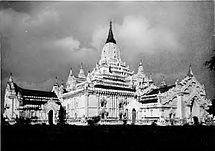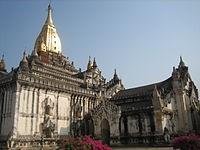Ananda pagoda History
History of this perfectly dimensioned temple structure built in 1105 is credited to King Kyanzittha. It denotes "the stylistic end of the Early Bagan period and the beginning of the Middle period".[2] The timing of building this temple is considered as a culmination of religious education that began during the Pahothanya temple building activity in 1080 AD. The Theravada Buddhism adopted by the King motivated him to present the teachings of Buddha to his people in an accurate and a genuine way through the medium of this temple, to unite Burma under one flag and thus "creating mass religious enthusiasm". It has been inferred that the King, as the upholder of the Law wanted to convey his firm belief in the Buddhist doctrine according to his interpretation:[3]
(He) shall purify (and) make straight, write down (and) establish all the holy scriptures. (He) shall proclaim (and) voice the Law, which is even as a resounding drum. (He) shall arouse all the people that are slumbering carelessly. (He) shall stand steadfast in the observance of the commandments at all times.
Through the unique iconographic depictions (in stone images, the numbered jataka plaques and the standing Buddha images), presented in the symmetrically planned layout of the Ananda temple was built by the King Kyanzittha to establish and convey his doctrine to his people in a vivid visual format.[3] It is said that the King who founded this temple became illustrious in the sphere of Buddhist architecture.[9]
Architectural history


Ananda Temple in 1890s (left) and 2007
The architectural history of the temple has been widely analysed. While the Mon architecture of Burmese origin is noted, strong influence of Indian Architecture from many temples of Bengal and Orissa is very clear. In this regard archaeologist Duroiselle has made these observations:[6] "There can be no doubt that the architects who planned and built the Ananda were Indians. Everything in this temple from Shikara to basement, as well as the numerous stone sculptures found in its corridors, and the terra-cotta plaques adorning its basement and terraces, bear the indubitable stamp of Indian genius and craftsmanship...In this sense we may take it, therefore, that the Ananda, though built in the Burmese capital, is an Indian temple." It is also said that the architecture of this temple greatly represents the Ananta cave temple in Udayagiri hills in Orissa, India.